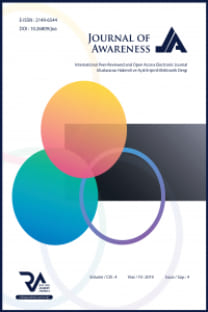The case of cultural schizophrenia: Alleged tampering with DNA codes via Covid-19 vaccines
Biopolitics, Vaccine Resistance, Disinformation, Reproductivity, Turkey
The case of cultural schizophrenia: Alleged tampering with DNA codes via Covid-19 vaccines
Biopolitics, Vaccine Resistance, Disinformation, Reproductivity, Turkey,
___
- ASHMORE, M. (1989). The Reflexive Thesis: Writing Sociology of Scientific Knowledge. University of Chicago Press, Chicago.
- ASHMORE, M. (2001). Reflexivity, in Science and Technology Studies. International Encyclopedia of the Social & Behavioral Sciences, Pages 12881–12884.
- BECK, U. (1997). The Reinvention of Politics. Cambridge: Polity Press.
- BIJKER, W. (1992). “Do not despair: there is life after constructivism.” Shaping Technology/Building Society, edited by Wiebe Bijker and John Law (eds) 181(1993)113–38 (1992). Cambridge, MA: MIT Press.
- BIJKER, W., HUGHES, T., AND TREVOR, P., (eds). (1987). The Social Construction of Technological Systems. Cambridge, MA: MIT Press.
- BLOOR, D. (1991). Knowledge and Social Imagery, second edit. Chicago: University of Chicago Press.
- CALLON, M. (1980). “Struggles and Negotiations to Decide What Is Problematic and What Is Not: The Sociology of Translation.” In The Social Process of Scientific Investigation, ed. Karin Knorr, Roger Krohn, and Richard Whitley, pp. 197–220. Dordrecht, Holland: Reidel.
- CALLON, M. (1986). Some Elements of a Sociology of Translation: Domestication of the Scallops and the Fisherman of St. Brieuc Bay.
- CALLON, M. (2001). “Actor-Network Theory,” in Smelser N., Baltes P., (ed.), International Encyclopedia of the Social and Behavioral Sciences., Oxford, U.K., Pergamon, p.62–66.
- CALLON, M., LATOUR, B. (1981). “Unscrewing the Big Leviathans: How Do Actors Macrostructure Reality and How Sociologists Help Them.” In Advances in Social Theory and Methodology: Toward an Integration of Micro and Macro Sociologies, ed. Karin Knorr and Aron Cicourel, pp. 277- 303. London: Routledge.
- CALLON, M.; LAW; AND RIP, A. (1986). Mapping the Dynamics of Science and Technology. London: Macmillan, ed.
- GEERTZ, C. (1973). The Interpretation of Cultures. New York: Basic Books.
- HABERMAS, J. (1991). “The public sphere” In Mukerji, C.; Schudson, M. (Ed.): Rethinking popular culture. Contemporary perspectives in cultural studies. Berkeley/Los Angeles: University of California Press. pp.398–404.
- HOLLIS, M, AND LUKES, S. (1982). Rationality and Relativism. MIT Press.
- JABLENSKY, A., & SARTORIUS, N. (1975). Culture and Schizophrenia. Psychological Medicine, 5(2), 113- 124. doi:10.1017/S003329170005635X
- KNORR CETINA, K. (1981). The Manufacture of Knowledge. New York: Pergamon.
- KNORR CETINA, K. (1983). “The ethnographic study of scientific work,” in Edited by: Karin Knorr Cetina and Michael Mulkay (eds), Science Observed. Beverly Hills, CA: Sage. pp. 115–40.
- KNORR CETINA, K. (1985). “Germ Warfare.” The Social Process of Scientific Investigation, edited by Karin; Krohn, Roger; and Whitley, Richard, eds. 1981. Dordrecht, Holland: Reidel. Social Studies of Science 15:577-588.
- KNORR CETINA, K. (1995). “Laboratory studies,” Handbook of Science and Technology Studies, edited by: Sheila Jasanoff, Gerald E. Markle, James C. Peterson, and Trevor Pinch, Thousand Oaks, CA: Sage. pp. 140–66.
- KNORR CETINA, K. (1998). Epistemic Cultures. Cambridge, MA: Harvard University Press.
- KOCENDA, E., CABELKA, Z. (1998). “Liberalization in the Energy Sector: Transition and Growth,” Research Paper in International Conference of European Studies, Havana.
- KUCUKVAR, M., ONAT, N.C., HAIDER. M.A. (2018). “Material dependence of national energy development plans: the case for Turkey and United Kingdom.” J. Clean. Prod., 200, pp. 490–500.
- KUHN, T. S. (1962). The Structure of Scientific Revolutions. Chicago: University of Chicago Press.
- LATOUR, B, AND BASTIDE, F. (1986). “Fact and Fiction Writing.” In Mapping the Dynamics of Science and Technology, ed. M. Callon, J. Law, and A. Rip. London: Macmillan.
- LATOUR, B. (1981). “Who Is Agnostic? Alternatively, What Could It Mean to Study Science?” In Knowledge and Society: Studies in the Sociology of Culture Past and Present, ed. R. Jones and R. Kuclick. Greenwich: JAI Press, 3: pp. 199–216.
- LATOUR, B. (1983). “Give Me a Laboratory, and I Will Raise the World.” In Science Observed: Perspectives on the Social Study of Science, ed. K. Knorr and M. Mulkay. Los Angeles: Sage.
- LATOUR, B. (1986). “Visualization and Cognition.” In Knowledge and Society: Studies in the Sociology of Culture Past and Present, ed. H. Kuclick. Greenwich: JAI Press, 6:1-40.
- LATOUR, B. (1986a). “The Powers of Association.” In Power, Action, and Belief: A New Sociology of Knowledge? Ed. John Law. Sociological Review Monograph. Keele: Methuen, pp. 264–280.
- LATOUR, B. (1988). “A Politics of Explanation” In Knowledge and Reflexivity, ed. S. Woolgar. London: Sage.
- LATOUR, B. (1996). On actor-network theory: A few clarifications. Soziale Welt, 369-381.
- LATOUR, B. (1987). Science in Action: How to Follow Scientists and Engineers Through Society. Cambridge: Harvard University Press.
- LEFEBVRE, H. (2014). Critique of Everyday Life. Verso.
- LYNCH, M. (1985). Art and Artifact in the Laboratory. London: Routledge.
- NGUYEN, C. (2020). Echo Chambers and Epistemic Bubbles. Episteme, 17(2), 141-161. doi:10.1017/ epi.2018.32
- PERSILY, N, AND JOSHUA A. TUCKER, eds. (2020). “Social Media and Democracy.” Social Media and Democracy: The State of the Field, Prospects for Reform, i-i. SSRC Anxieties of Democracy. Cambridge: Cambridge University Press.
- SHAYEGAN, D. (1997). Cultural Schizophrenia: Islamic societies confronting the West. Syracuse, N.Y.: Syracuse University Press.
- ISSN: 2149-6544
- Başlangıç: 2016
- Yayıncı: Rating Academy
The case of cultural schizophrenia: Alleged tampering with DNA codes via Covid-19 vaccines
Sarnıç temalı kültür rotası oluşturulması; İstanbul Tarihi Yarımadası Örneği
Mustafa Yağız FIRAT, Adem Erdem ERBAŞ
Dijital çağda medya ve hastalıkları
The use of textures as a visual design element in cut-out illustrations
Enerji güvenliği politika yapıcı aktörler
İletişim dünyasının Higgs Bozonu: Yeni medya
Kültürlerarası pazarlama iletişimi farklılıkları
Dijital teknoloji çağında müzik
Dijital girişimcilik ekosisteminde sürdürülebilirlik
